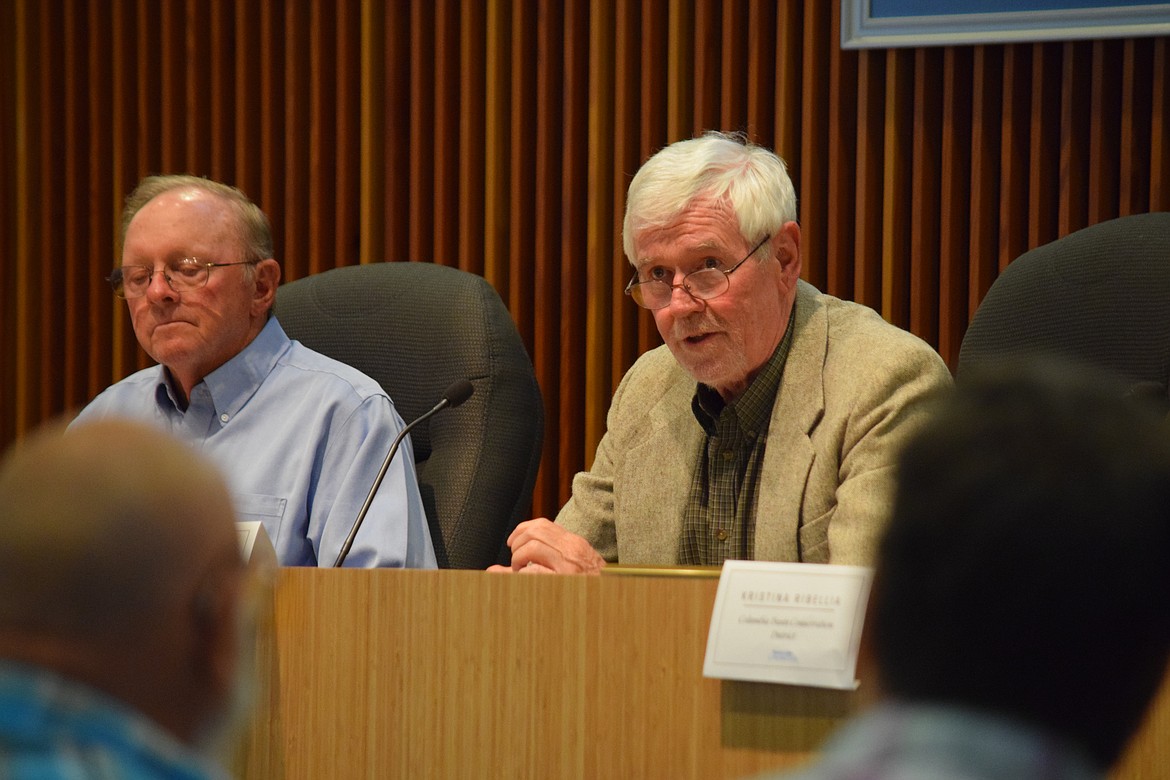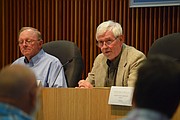State of the lake
MOSES LAKE — Preventing future blooms of dangerous blue-green algae in the waters of Moses Lake is going to take a lot of slow and deliberate effort on the part of everyone who lives, works and plays on and around the lake, according to members of the Moses Lake Watershed Council during a “State of Our Lake” meeting Tuesday night.
“We will deal with this on the lake forever, but it can be managed and monitored,” Harold Crose, a resource conservationist with the Columbia Basin Conservation District and the chair of the watershed council.
Crose said during the public meeting that phosphorus levels in the lake are the main contributor to the problem of blue-green algae blooms in the lake, but the agencies responsible for the lake like the council, the Moses Lake Irrigation and Rehabilitation District, and even lakeshore residents, can help keep phosphorus levels manageable. Doing so can help people keep boating and fishing on the lake.
In the last few years, the lake has been plagued with blooms of blue-green algae — in reality, a type of bacteria that needs phosphorus as an essential nutrient — that can produce both a liver toxin, microcystin, and a nerve toxin, anatoxin-A, when they die, according to Kelsey Jacobs, an environmental health specialist with the Grant County Health District. The toxins, which can persist in the water long after the blue-green algae die off, are dangerous to humans and animals, Jacobs said.
“Cyanobacteria grow rapidly in fresh water when conditions are right. Unfortunately, right now, conditions are right (for algae to propagate),” she said. “Blooms may persist into October, and microcystin is persistent, and can stay (at high levels in the water) into November.”
While 2022 has been a good year for water quality in Moses Lake, the health district last Friday issued a warning and posted a sign near the Blue Heron Park boat ramp warning of high levels of microcystin at that location in the lake.
Jacobs said the safe limit for microcystin is 8 parts per billion, and a sample tested from Blue Heron park had over 800 parts per billion of the toxin.
“Don’t drink the water, and avoid activities where you have skin contact with or ingest the water,” she said. “We will continue to take samples until it’s below 8 parts per billion for two weeks in a row or until the state funding (for the testing program) runs out.”
Crose said of the phosphorus in the lake, about 50% comes from both Rocky Ford Creek and Crab Creek, while the other half is currently sitting in sediments at the bottom of Moses Lake. Clean Columbia River Water flows through Moses Lake as part of the Columbia Basin Project’s provision of irrigation water to parts of Grant, Adams and Franklin counties diluting lake phosphorus levels. However, Crose said that water also brings in phosphorus-rich sediments that contribute to the problem.
Currently, the state standards for phosphorus are 30 parts per billion, though Crose said the watershed council is aiming for a sustained phosphorus level of 20 parts per billion.
“We can achieve that over time,” he said.
As part of that effort, the MLWC has received a $3.1 million grant to treat sediments in the Rocky Ford arm of the lake next spring with a chemical that will remove the phosphorus from the water and lock it in lake sediments. Crose said any treatment will buy the region time so the city of Moses Lake can craft its lakeshore management plan and the watershed council can create its watershed management plan. The goal is to look at all sources, including run-off from lakefront lawns and leaky septic tanks, which contribute up to 30% of the lake’s phosphorus, Crose explained.
“We want to get the phosphorus to the point where we don’t need signs,” he said.
Phosphorus levels vary from year to year, depending on how much water the U.S. Bureau of Reclamation — which oversees the Columbia Basin Project — runs through the lake, Crose said.
However, Gina Hoff, a water quality specialist with the bureau, said USBR’s central goal is to ensure that there’s enough water to the three irrigation districts in the project. Providing irrigation water is tough enough now given that demand is high and the East Columbia Basin Irrigation District is building out feeder canals for farmers who have long been promised water.
“There’s not really excess water to give to Moses Lake for dilution,” she said. “We can help a bit, but not much.”
What both the USBR and the Washington State Department of Ecology have, however, is money in the form of grants that can help the irrigation districts improve their systems, the conservation district to craft management plans and homeowners to improve their septic systems.
“We have a robust grant program, and we gave $317 million in 2021 for clean water projects. We can fund all types of water quality projects,” said Amanda Richardson, a watershed implementation lead for Ecology’s Water Quality Program. “We’re mostly in a support role, letting locals take the lead.”
Charles H. Featherstone can be reached at cfeatherstone@columbiabasinherald.com.





